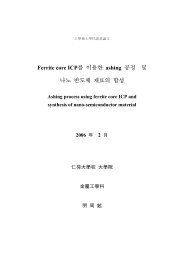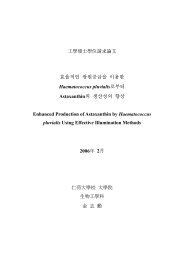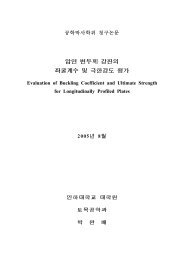저작자표시-비영리-변경금지 2.0 대한민국 이용자는 아래의 조건을 ...
저작자표시-비영리-변경금지 2.0 대한민국 이용자는 아래의 조건을 ...
저작자표시-비영리-변경금지 2.0 대한민국 이용자는 아래의 조건을 ...
You also want an ePaper? Increase the reach of your titles
YUMPU automatically turns print PDFs into web optimized ePapers that Google loves.
matrix. However, CNTs are strongly affected by van der Waals force<br />
due to their small size and large surface area. These forces give rise to<br />
the formation of aggregates, which in turn, make dispersion of CNTs in<br />
the polymers difficult. In order to attain an efficient dispersion of CNTs<br />
by the physical approach, ultrasound can be applied to a dispersion of<br />
CNTs. [9] In addition, chemical methods such as covalent attachment<br />
involving the introduction of a chemical group to the nanotube wall,<br />
and non-covalent adsorption methods have been employed in order to<br />
provide chemical compatibility with the polymers, and dissolution of<br />
CNTs in organic solvents. [10-12]<br />
Generally, the following three methods for the preparation of<br />
polymer-CNTs nanocomposite are employed to promote the dispersion<br />
of controlled CNTs throughout the polymer matrix: (i) solution blending,<br />
a method for precipitating or casting a polymer-CNTs solution<br />
dissolved in a solvent, [13,14] (ii) melt mixing, which requires high<br />
temperature and shear force according to the polymer species in the<br />
mixer without a solvent and (iii) in-situ polymerization, a method to<br />
polymerize the monomer in the presence of the dispersed-CNTs. This<br />
last approach has outstanding potential which can include covalent<br />
bonding between the polymer matrix and modified-CNTs. [16,17]<br />
2







